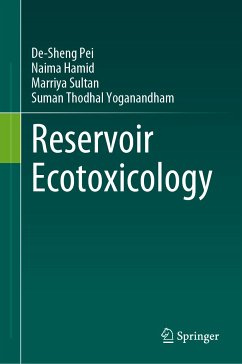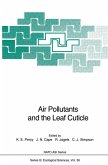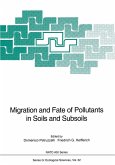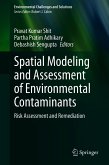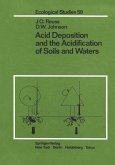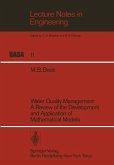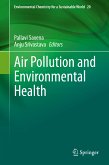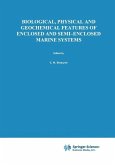Reservoir Ecotoxicology (eBook, PDF)


Alle Infos zum eBook verschenken

Reservoir Ecotoxicology (eBook, PDF)
- Format: PDF
- Merkliste
- Auf die Merkliste
- Bewerten Bewerten
- Teilen
- Produkt teilen
- Produkterinnerung
- Produkterinnerung

Hier können Sie sich einloggen

Bitte loggen Sie sich zunächst in Ihr Kundenkonto ein oder registrieren Sie sich bei bücher.de, um das eBook-Abo tolino select nutzen zu können.
Reservoir construction is the key strategy for water resource management. In recent years, the migration of pollutants and their transformation into the reservoir ecosystem has become a global problem. Intensified anthropogenic activities and unsustainable practices have amplified the pollutant levels in the reservoir. Therefore, this book intends to highlight environmental characteristics of the reservoir, study methods of ecotoxicology, and mechanistic toxicogenetic pathways of pollutants in the reservoir. Adverse outcome pathway (AOPs) model is used to elucidate toxicological effects of…mehr
- Geräte: PC
- ohne Kopierschutz
- eBook Hilfe
- Größe: 6.46MB
![Air Pollutants and the Leaf Cuticle (eBook, PDF) Air Pollutants and the Leaf Cuticle (eBook, PDF)]() Air Pollutants and the Leaf Cuticle (eBook, PDF)113,95 €
Air Pollutants and the Leaf Cuticle (eBook, PDF)113,95 €![Migration and Fate of Pollutants in Soils and Subsoils (eBook, PDF) Migration and Fate of Pollutants in Soils and Subsoils (eBook, PDF)]() Migration and Fate of Pollutants in Soils and Subsoils (eBook, PDF)113,95 €
Migration and Fate of Pollutants in Soils and Subsoils (eBook, PDF)113,95 €![Spatial Modeling and Assessment of Environmental Contaminants (eBook, PDF) Spatial Modeling and Assessment of Environmental Contaminants (eBook, PDF)]() Spatial Modeling and Assessment of Environmental Contaminants (eBook, PDF)121,95 €
Spatial Modeling and Assessment of Environmental Contaminants (eBook, PDF)121,95 €![Acid Deposition and the Acidification of Soils and Waters (eBook, PDF) Acid Deposition and the Acidification of Soils and Waters (eBook, PDF)]() J. O. ReussAcid Deposition and the Acidification of Soils and Waters (eBook, PDF)40,95 €
J. O. ReussAcid Deposition and the Acidification of Soils and Waters (eBook, PDF)40,95 €![Water Quality Management (eBook, PDF) Water Quality Management (eBook, PDF)]() M. B. BeckWater Quality Management (eBook, PDF)73,95 €
M. B. BeckWater Quality Management (eBook, PDF)73,95 €![Air Pollution and Environmental Health (eBook, PDF) Air Pollution and Environmental Health (eBook, PDF)]() Air Pollution and Environmental Health (eBook, PDF)161,95 €
Air Pollution and Environmental Health (eBook, PDF)161,95 €![Biological, Physical and Geochemical Features of Enclosed and Semi-enclosed Marine Systems (eBook, PDF) Biological, Physical and Geochemical Features of Enclosed and Semi-enclosed Marine Systems (eBook, PDF)]() Biological, Physical and Geochemical Features of Enclosed and Semi-enclosed Marine Systems (eBook, PDF)113,95 €
Biological, Physical and Geochemical Features of Enclosed and Semi-enclosed Marine Systems (eBook, PDF)113,95 €-
-
-
Dieser Download kann aus rechtlichen Gründen nur mit Rechnungsadresse in A, B, BG, CY, CZ, D, DK, EW, E, FIN, F, GR, HR, H, IRL, I, LT, L, LR, M, NL, PL, P, R, S, SLO, SK ausgeliefert werden.
- Produktdetails
- Verlag: Springer International Publishing
- Seitenzahl: 234
- Erscheinungstermin: 8. April 2023
- Englisch
- ISBN-13: 9783031263446
- Artikelnr.: 67754619
- Verlag: Springer International Publishing
- Seitenzahl: 234
- Erscheinungstermin: 8. April 2023
- Englisch
- ISBN-13: 9783031263446
- Artikelnr.: 67754619
- Herstellerkennzeichnung Die Herstellerinformationen sind derzeit nicht verfügbar.
Ms. Marriya Sultan is currently enrolled in a Ph. D. program in environmental sciences at Chongqing Institute of Green and Intelligent Technology, Chinese Academy of Sciences under a CAS-TWAS fellowship 2019. Previously, she obtained her M.Phil degree in environmental sciences from Quaid-I-Azam University, Islamabad Pakistan. Currently, she is working on a Ph.D. project, entitled "Co-existing characteristics of microplastics and DEHP in the Three Gorges Reservoir Area and mechanism of compound reproductive toxicity on zebrafish model", under the supervision of Prof. & Dr. De-Sheng Pei. Her expertise includes the characterization of organic and inorganic environmental pollutants (exposure routes, dose-response, and mode of action), rigorous evaluations of contamination using novel techniques, and analysis of environmental pollutants data.
Dr. Thodhal Yoganandham Suman got his Ph.D. degree from Sathyabama University in 2017. From Jun 2014 to Dec 2018, Dr. T.Y.Suman worked at the Center of Ocean Research in Sathyabama University as a Senior Scientific Assistant. From Dec. 2018 to Mar. 2021, as a Postdoctoral research fellow, Dr. T.Y.Suman concentrated his study on the characterization of marine plastic debris and the effect of microplastics on aquatic organisms at Henan Normal University & Chongqing Institute of Green and Intelligent Technology (China). He currently works as a postdoctoral research fellow for environment engineering at Changwon National University, South Korea. His research in Ecotoxicology is mainly focusing on micropollutants and their environmental impacts. His research interests are in molecular biology especially using omics-based methods to understand how aquatic organisms respond to stressors. He is particularly interested in studying gene expression and its pathway.
